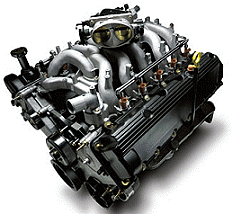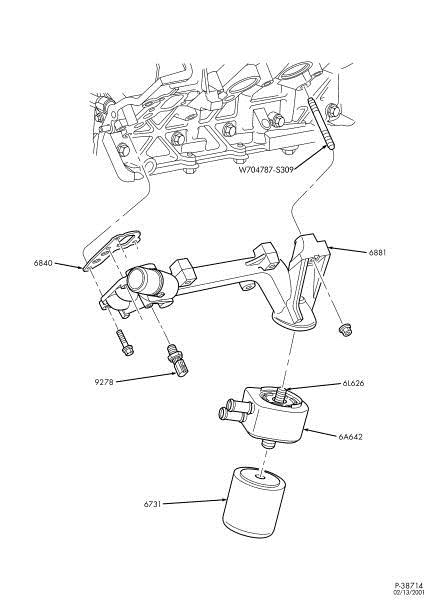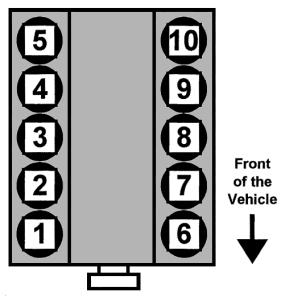
The 6.8 L (413 CID) SOHC V10 is a variation of the Modular family created for use in large trucks.
Bore size is 90.2 mm (3.552 in) and stroke is 105.8 mm (4.165 in), identical to the 5.4 L V8. Both 2-valve and 3-valve versions have been produced. The 6.8 L uses a split-pin crank with 72° firing intervals and a balance shaft to quell vibrations inherent to a 90° bank angle V10 engine. The engine’s firing order is 1-6-5-10-2-7-3-8-4-9. The 2-valve version was first introduced in 1997, with a 3-valve non-VCT version to follow in 2005. The 3-valve engines were built alongside the 2-valve engines at Ford’s Windsor, Ontario LVL engine line, but moved production to the larger Windsor Engine Plant in 2009.
2-Valve: Vehicles equipped with the 2-valve 6.8 L V10 Modular engine include the following:
| Vehicle Name | Production Years | Engine Output |
| Ford E250-E450 / F53 Motorhome | 1997–2004 | 305 hp / 420 lb·ft |
| Ford F250-F550 / F53 Motorhome | 1997–2004 | 310 hp / 425 lb·ft |
| Ford F250-F550 / F53 Motorhome | 2005-2010 | 362 hp / 457 lb·ft |
| Ford Excursion | 2000-2005 | 310 hp / 425 lb·ft |
| Ford E350 & E450 | 2014- Current | 305 hp / 420 lb·ft |
3-Valve: Vehicles equipped with the 3-valve 6.8 L V10 Modular engine include the following:
| Vehicle Name | Production Years | Engine Output | Notes |
| Ford Super Duty | 2005-2010 2017+ |
||
| F450-F550 Chassis Cab | 2005–present | ||
| F53, F59 stripped chassis | 2005–present | 362 hp / 457 lb·ft | |
| Ford F-650/F-750 Super Duty | 2012- Current | ||
| Blue Bird Vision | 2010–present | 362 hp / 457 lb·ft | Equipped to run on propane |
Key features and benefits:
One camshaft in each cylinder head (at the top of each cylinder bank) operating 3 valves, 2 intake and 1 exhaust
SOHC design provides an advanced level of valve control
Deep-skirt engine block and low-friction internal components mean greater reliability and fuel economy
Electronic throttle control uses electronic sensors instead of mechanical linkage to deliver seamless and consistent engine response
Silent-design chain cam drive contributes to durability and helps reduce NVH (Noise, Vibration and Harshness) characteristics
Coil-on-plug ignition system design for high-mileage durability
90,000-mile spark plug maintenance interval with regular fluid and filter changes – under normal driving conditions
Fail-safe cooling system is designed to help protect the engine from potential damage due to a loss of coolant. If the engine overheats, it will automatically switch from 10-cylinder operation to alternating 5-cylinder operation. The vehicle will continue to operate, but with limited engine power. This system allows the driver to travel a short distance to obtain service or reach a service facility if the engine overheats. The distance that can be traveled depends upon vehicle load, outside temperature and road conditions
Ford V10 Firing Order
| Ford 6.8L V10 Specifications | |
| Displacement / Type | 6.8L V10 (415 CID) |
| GVWR / GCW | up to 33,000 lbs. |
| Valve Lifters | Hydraulic lifter coupled to roller finger follower |
| Firing Order | 1-6-5-10-2-7-3-8-4-9 |
| Horsepower | 362 hp |
| Torque | 457 ft-lbs |
| Bore / Stroke (inches) | 3.55 x 4.16 |
| Compression Ratio | 9.2:1 |
| Main Bearings | 6 |
| Valve Lifters | Hydraulic Lash Adjuster with Roller Follower |
| Fuel Delivery | Sequential Multi-port Electronic Fuel Injection |
| Throttle control | Electronic |
| Block | Cast iron |
| Cylinder Head | Aluminum |
| Intake Manifold | Composite |
| Exhaust Manifold | Cast stainless steel |
| Crankshaft | Forged steel |
| Connecting Rods | Powdered metal |
| Main Bearing Caps | 4 bolt with 2 dowels |
| Ignition | Coil on plug |
| Maximum Engine Speed | 5,200 rpm (no load) |
| Oil System | 7 quarts of 5W20 |
| Emissions Controls | Dual three-way catalyst. Positive crankcase ventilation. |
| Valvetrain | Overhead cam (2 or 3 valves per cylinder) |
| Weight | 620 lbs |
Known Problems:
The Ford V10 is a very reliable motor, and has been known to exceed 300,000 miles. It does have a few known problems:
Spark Plugs Shooting Out The The Heads:
Spark plugs on the V10 need to be checked and torqued if needed. They are known to come loose and shoot out of the cylinder head and strip out the threads. The repair involved reaming the spark plug hole, tapping it and inserting a helicoil to hold a factory spark plug.
You can find these repair kits at the bottom of this page.
Engine Running Rough / Misfiring:
If you’re having a problem with your V10 running rough / missing, it may be your Coil On Plugs (COP). The V10 has an ignition coil mounted on top of each spark plug. These can fail over time if they’re exposed to moisture. The ones closest to the firewall are the ones that most commonly fail (#5 & #10). The engine may not display a check engine light if it has a misfire. If you can get access to a diagnostic tool that can read the codes on the V10, you should be able to get codes from the bad COP. The code will directly correspond to the bad coil. The codes are:
| P305 – Cylinder #5 Misfire | P310 – Cylinder #10 Misfire |
| P304 – Cylinder #4 Misfire | P309 – Cylinder #9 Misfire |
| P303 – Cylinder #3 Misfire | P308 – Cylinder #8 Misfire |
| P302 – Cylinder #2 Misfire | P307 – Cylinder #7 Misfire |
| P301 – Cylinder #1 Misfire | P306 – Cylinder #6 Misfire |
You can find good deals on replacement coils at the bottom of this page.
Exhaust Manifold Studs Rust And Break:
The factory studs rust and break off causing an exhaust leak. The repair involves removing the remaining nuts to remove the exhaust manifold. Then a nut is welded on to the remaining stud. The heat of the welder usually causes it to come loose, and can be removed by using a socket on the welded nut.
Oil Consumption:
The V10 is known for using oil. It’s not uncommon for them to use up a quart of oil between oil changes.
Oil Leak:
If you have an oil leak from the drivers side of the engine block, it may be coming from the seal between the engine block, and oil cooler adapter.


